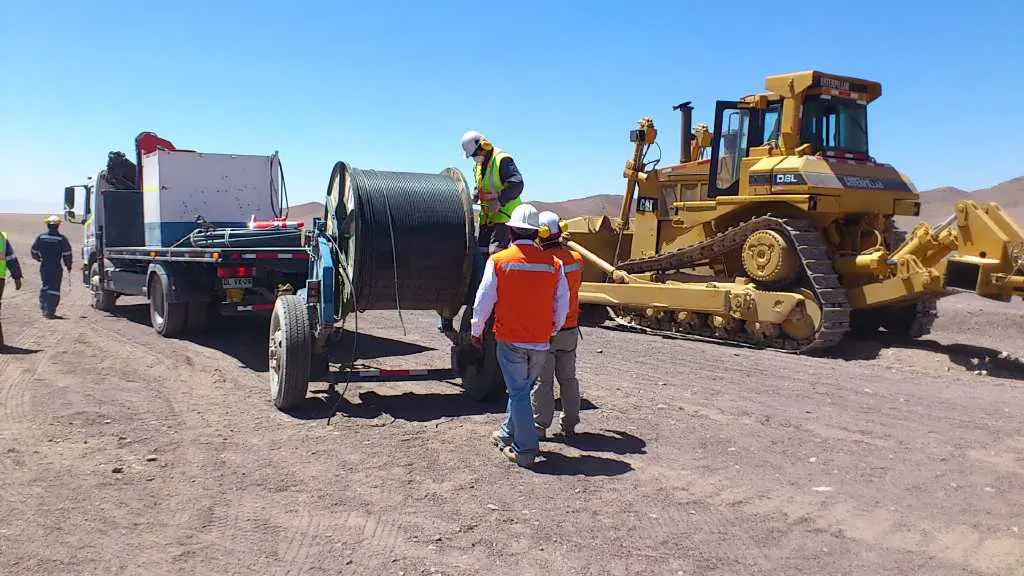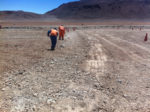ALMA Gains Broadband Connection with Global Science Community
ALMA’s remote location is a boon to astronomy but a telecommunication challenge for the astronomers who work there. Thanks to a newly installed broadband fiber-optic line between the ALMA Operations Site (AOS) and the city of Calama in northern Chile, astronomers from around the world now have high-speed access, 25 times faster than before, to this world-class telescope.
The new system uses 150 kilometers of fiber optic cable to cover the distance from the astronomical observatory to the city of Calama, where it is then linked, through an existing high-speed communication line, to the research and academic network operated by REUNA (Red Universitaria Nacional) in Antofagasta that, thanks to the infrastructure that was developed as part of the EVALSO project, connects to the ALMA offices in Santiago, where the data are processed and shared with astronomers around the world.
"This important milestone for ALMA draws upon the enormous scientific potential of this observatory, by providing an enormous amount of data, with astonishing speed, to the scientific community of the Member States involved in the ALMA observatory and, thereby, reach the world’s scientific community" said Dr. Eduardo Hardy, representative in Chile for Associated Universities Inc. (AUI).
"This new infrastructure not only allows transmitting the enormous amount of data generated by ALMA, but it also improves the level of communication between the people operating the observatory at a remote site in the middle of the Atacama Desert and those who process that data in the central offices in Santiago" said Giorgio Filippi, project leader, who is a staff member of the European Southern Observatory (ESO), that represents the European partners of ALMA.
This project culminated with technical testing of data transmission between the Chajnantor Plateau, situated at an altitude of 5.000 meters above sea level, where ALMA’s 66 antennas are located, and the main offices in Santiago. Although the full capacity of the installed network was not used, two channels with a capacity exceeding 1 Gbps (Gigabite per second) were successfully tested.
"This successful preliminary test confirmed the proper operation of ALMA’s new digital road and opens a number of new possibilities to further enhance the operation of the array and the transmission of scientific data from the observatory," said Jorge Ibsen, Director of the Computing Department of the Joint ALMA Observatory (JAO).
The new connectivity system is the result of a Memorandum of Understanding signed between the National Radio Astronomy Observatory (NRAO) – operated by AUI – and REUNA. It is planned to become fully operational in the upcoming months once the administrative process is finished.
More information
The Atacama Large Millimeter/submillimeter Array (ALMA), an international astronomy facility, is a partnership of the European Organisation for Astronomical Research in the Southern Hemisphere (ESO), the U.S. National Science Foundation (NSF) and the National Institutes of Natural Sciences (NINS) of Japan in cooperation with the Republic of Chile. ALMA is funded by ESO on behalf of its Member States, by NSF in cooperation with the National Research Council of Canada (NRC) and the National Science Council of Taiwan (NSC) and by NINS in cooperation with the Academia Sinica (AS) in Taiwan and the Korea Astronomy and Space Science Institute (KASI).
ALMA construction and operations are led by ESO on behalf of its Member States; by the National Radio Astronomy Observatory (NRAO), managed by Associated Universities, Inc. (AUI), on behalf of North America; and by the National Astronomical Observatory of Japan (NAOJ) on behalf of East Asia. The Joint ALMA Observatory (JAO) provides the unified leadership and management of the construction, commissioning and operation of ALMA.
Contact:
Nicolás Lira
Education and Public Outreach Assistant
Joint ALMA Observatory
Santiago, Chile
Tel: +56 2 467 6519
Cell: +56 9 9445 7726
Email: [email protected]
Charles E. Blue
Public Information Officer
National Radio Astronomy Observatory
Charlottesville, Virginia, USA
Tel: +1 434 296 0314
Cell: +1 434.242.9559
E-mail: [email protected]
Richard Hook
Public Information Officer, ESO
Garching bei München, Germany
Tel: +49 89 3200 6655
Cell: +49 151 1537 3591
Email: [email protected]
Masaaki Hiramatsu
Education and Public Outreach Officer, NAOJ Chile
Observatory Tokyo, Japan
Tel: +81 422 34 3630
E-mail: [email protected]


